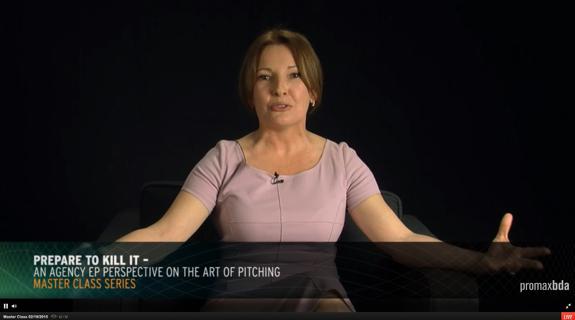Mastering the perfect pitch is a simple matter of preparation and hard work, iartists’ Danixa Diaz said at PromaxBDA’s monthly Digital Master Class on Thursday.
Diaz is in a position to know. Before founding Marina Del Rey, Calif.-based iartists, a representation firm focused on connecting top creative agencies with opportunities across various disciplines, she spent seven years as the director of business development at Imaginary Forces. Prior to that, she was executive producer at 3 Ring Circus.
Creating the perfect pitch starts with asking the right questions, and Diaz had a long list of them, including:
—What’s the target audience for this project?
—What are the brand attributes?
—Who are the decision-makers?
—Will you have visual references from which to work?
—Will you have access to the current style guide?
—and perhaps the most important and trickiest question: What’s the budget?
Diaz offered this tip for extracting a little more information about a potential project’s budget parameters: After getting as much information about the project at hand, do a little math in your head to try to estimate where the budget might be. Toward the end of the conversation, bring up a budget range that at least doubles what you think the actual budget is. So, if you estimate a budget of $200,000 for the entire project, say something to the effect of: “Based on my experience, this should fall between $200,000 and $500,000.” And then sit back and listen to how the client reacts to that broad estimate.
You also want to know if this is a competitive pitch or if you’ll be a single bidder. If you have a previous relationship with this client, you should be in a good position to ask to limit the process to a single bid, at least during the initial design phase, says Diaz. If the client doesn’t like what you have to pitch at that point, then they can avail themselves of the option to bring in other bidders. That said, if you’ve created the perfect pitch, that shouldn’t be necessary.
Once you are in the door, you have some internal work to do. One of the most important parts of the pitching process is getting the internal team on board.
“If your entire team is excited about the opportunity, that will make a difference in your outcome,” Diaz said.
It’s also important to share all of the information that you’ve gathered with your entire team, and work together to analyze it.
After you and your team have decided to pursue the project, you want to prepare a “tight presentation with a strong point of view,” says Diaz. “Once you’ve gotten the opportunity, how do you prepare to kill it?”
The answer to that question is “preparation and attention to detail,” says Diaz.
Prior to heading into the big pitch:
—Your entire team should be excited about the project;
—You’ve done your homework;
—You’ve shared all the information verbally and in writing with your team more than once;
—Your team has communicated with the stakeholders and client(s) more than once;
—The client and/or your boss is giving you good feedback and offering additional information;
—You’ve rehearsed the presentation and will be able to present in person before all of the decision makers;
—and you’ve flagged some good ideas that might fall outside the budget range.
“If your idea didn’t make it, somewhere there was a weak link unless your client or boss decided to move away from the project for reasons you couldn’t control,” Diaz says.
PromaxBDA offers monthly Digital Master Classes. In March, Lorenzo de Guttadauro, senior VP of brand and creative at Esquire Network, will lead “Promo is Dead, Long Live Promo!” on Thursday, March 19, at 11 am PT.
The entire Digital Master Class series is available for PromaxBDA members to watch on demand at promaxbda.org.
Tags:













































__twocolumncontent.jpg)











